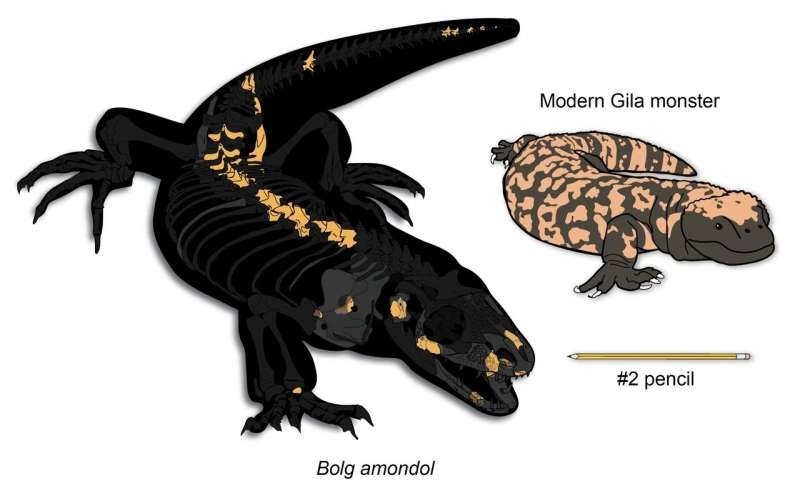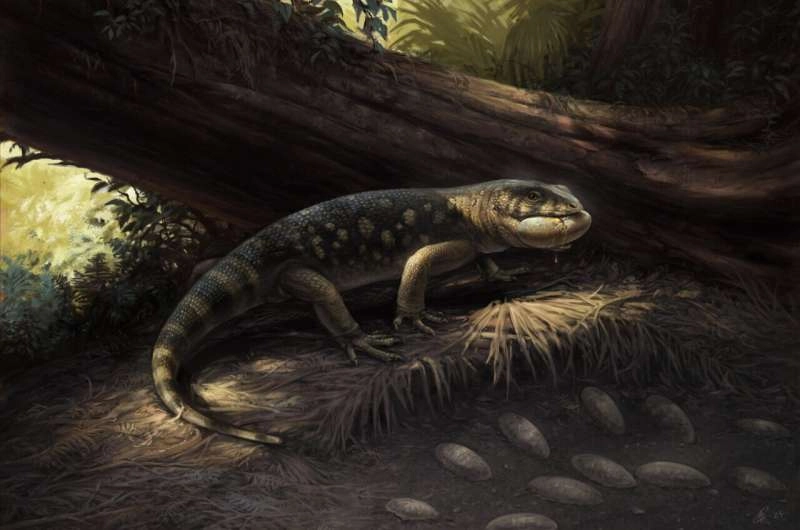morphosource.org. Credit: Natural History Museum of Utah/Bureau of Land Management>  Size comparison of the holotype specimen of Bolg amondol and a modern Gila monster (Heloderma suspectum, right). Gold: preserved skeletal elements. Light gray: reconstructed elements based on preserved material. Dark gray: missing skeletal elements, based off publicly available rendered CT scans of Heloderma horridum available on morphosource.org. Credit: Natural History Museum of Utah/Bureau of Land Management
Size comparison of the holotype specimen of Bolg amondol and a modern Gila monster (Heloderma suspectum, right). Gold: preserved skeletal elements. Light gray: reconstructed elements based on preserved material. Dark gray: missing skeletal elements, based off publicly available rendered CT scans of Heloderma horridum available on morphosource.org. Credit: Natural History Museum of Utah/Bureau of Land Management
A newly discovered, raccoon-sized armored monstersaurian from the Grand Staircase-Escalante National Monument in Southern Utah, United States, reveals a surprising diversity of large lizards at the pinnacle of the age of dinosaurs.
Named for the goblin prince from J.R.R. Tolkien's "The Hobbit," the new species Bolg amondol, also illuminates the sometimes-murky path that life traveled between ancient continents.
"I opened this jar of bones labeled 'lizard' at the Natural History Museum of Utah, and was like, oh wow, there's a fragmentary skeleton here," said lead author Hank Woolley from the Natural History Museum of Los Angeles County's Dinosaur Institute.
"We know very little about large-bodied lizards from the Kaiparowits Formation in Grand Staircase-Escalante National Monument in Utah, so I knew this was significant right away."
Published in the journal Royal Society Open Science , the collaborative research led by the Dinosaur Institute and the Natural History Museum of Utah (NHMU) reveals hidden treasures awaiting future paleontologists in the bowels of museum fossil collections, and the vast potential of paleontological heritage preserved in Grand Staircase-Escalante National Monument and other public lands.
"Discovering a new species of lizard that is an ancestor of modern Gila monsters is pretty cool in and of itself, but what's particularly exciting is what it tells us about the unique 76-million-year-old ecosystem it lived in," said co-author Randy Irmis, associate professor at the University of Utah and curator of paleontology at NHMU.
"The fact that Bolg co-existed with several other large lizard species indicates that this was a stable and productive ecosystem where these animals were taking advantage of a wide variety of prey and different micro-habitats."
 Artistic reconstruction of Bolg amondol, depicted raiding an oviraptorosaur dinosaur nest amidst the lush Kaiparowits Formation habitat. Credit: Cullen Townsend
Artistic reconstruction of Bolg amondol, depicted raiding an oviraptorosaur dinosaur nest amidst the lush Kaiparowits Formation habitat. Credit: Cullen Townsend
Bolg represents an evolutionary lineage that sprouted within a group of large-bodied lizards called monstersaurs, that still roam the deserts from which Bolg was recovered. Woolley knew that a new species of monstersaur called for an appropriate name from an iconic monster creator, Tolkien.
"Bolg is a great-sounding name. It's a goblin prince from 'The Hobbit,' and I think of these lizards as goblin-like, especially looking at their skulls," said Woolley.
He used the fictional Tolkien Elvish language Sindarin to craft the species epithet. "Amon" means "mound," and "dol" means "head," a reference to the mound-like osteoderms found on Bolg's and other monstersaur's skulls. "Mound-headed Bolg" would fit right in with the goblinsand it's revealing quite a bit about monstersaurs.
Hidden gems in collection drawers
The Bolg amondol discovery highlights the likelihood that more large-bodied lizards existed during the Late Cretaceous Period than previously thought.
Bolg, along with other fossils from the Kaiparowits Formation, demonstrate that at least three types of predatory lizards lived in the Late Cretaceous sub-tropical floodplains of what is now Southern Utah. Additionally, this find shows that unexplored diversity is waiting to be dug up both in the field and in paleontology collections.
"Bolg is a great example of the importance of natural history museum collections," Irmis said. "Although we knew the specimen was significant when it was discovered back in 2005, it took a specialist in lizard evolution like Hank to truly recognize its scientific importance and take on the task of researching and scientifically describing this new species."
 Identified bones belonging to Bolg amondol. They are not much to look at, but they are jam-packed with valuable information on the anatomy and lifestyle of Bolg amondol. Credit: Natural History Museum of Utah/Bureau of Land Management
Identified bones belonging to Bolg amondol. They are not much to look at, but they are jam-packed with valuable information on the anatomy and lifestyle of Bolg amondol. Credit: Natural History Museum of Utah/Bureau of Land Management
The researchers identified the new species from tiny pieces of skull, limbs, girdles, vertebrae and bony armor called osteoderms. Most fossil lizards from the age of dinosaurs are even scrappieroften just single, isolated bones or teethso despite their fragmentary nature, the parts of Bolg's skeleton that survived contain a stunning amount of information.
"That means more characteristics are available for us to assess and compare to similar-looking lizards. Importantly, we can use those characteristics to understand this animal's evolutionary relationships and test hypotheses about where it fits on the lizard tree of life," Woolley said.
Discover the latest in science, tech, and space with over 100,000 subscribers who rely on Phys.org for daily insights. Sign up for our free newsletter and get updates on breakthroughs, innovations, and research that matterdaily or weekly.
Stairway to monstersaurs
The monstersauria are characterized by their large size and distinctive features, such as sharp, spire-like teeth and pitted, polygonal armor attached to their skulls. They have a roughly 100-million-year history, but their fossil record is largely incomplete, making the discovery a big deal for understanding these charismatic lizards. Bolg would have been a bit of a monster to our eyes.
"Three feet tip to tail, maybe even bigger than that, depending on the length of the tail and torso," said Woolley. "So, by modern lizard standards, they're a very large animal, similar in size to a Savannah monitor lizard; something that you wouldn't want to mess around with."
Bolg's closest known relative hails from the other side of the planet in the Gobi Desert of Asia. Though dinosaurs have long been known to have traveled between the once-connected continents of the Late Cretaceous Period, Bolg reveals that smaller animals also made the trek, suggesting there were common patterns of biogeography across terrestrial vertebrates during this time.
The rocks where Bolg was discoveredthe Kaiparowits Formation of Grand Staircase-Escalante National Monumenthave emerged as a paleontological hotspot over the past 25 years, producing one of the most astounding dinosaur-dominated records in North America. Discoveries like this underscore the importance of preserving public lands in the Western U.S. for science and research.
"The exceptional record of big lizards from Grand Staircase-Escalante National Monument may prove to be a normal part of dinosaur-dominated ecosystems from North America, filling key roles as smaller predators hunting down eggs and small animals in the forests of Laramidia," said co-author Joe Sertich from the Smithsonian Tropical Research Institute and Colorado State University.
More information: New monstersaur specimens from the Kaiparowits Formation of Utah reveal unexpected richness of largebodied lizards in Late Cretaceous North America, Royal Society Open Science (2025). DOI: 10.1098/rsos.250435
Journal information: Royal Society Open Science
Citation: Bolg amondol: New monstersaur reveals complex evolutionary history of giant Gila monster relatives (2025, June 17) retrieved 18 June 2025 from https://phys.org/news/2025-06-bolg-amondol-monstersaur-reveals-complex.html
This document is subject to copyright. Apart from any fair dealing for the purpose of private study or research, no part may be reproduced without the written permission. The content is provided for information purposes only.


